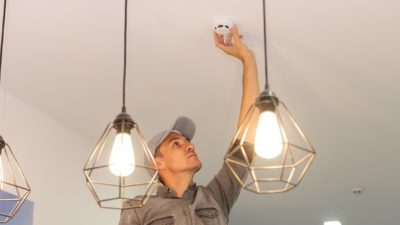The approximately 113 million residences in the U.S. collectively use about 22% of the country’s energy, according to the U.S. Department of Energy (U.S. DOE).
Whether you work from home all day or return from work to laundry, dishes, and a Zoom call from your friends, you probably use more energy than you think. Streaming Netflix? We’ll get to that. No matter what your daily routine looks like, you might be missing opportunities to adapt your daily habits to be more environmentally-friendly. Here are some energy-consumers in your home and some practical ways to combat wasting energy and money every day.
Heating and Cooling
Heating and cooling your home are by far the biggest users of energy at home. Here are some impactful energy efficiency statistics:
· Heating and cooling your home use more energy and costs more money than any other system in your home—typically making up about 54% of your utility bill. (energy.gov)
· You can reduce air conditioning energy use by 20-50% by switching to high-efficiency air conditioners and taking other actions to lower your home cooling costs. (energy.gov)
· Energy efficiency upgrades and a new high-efficiency heating system can often cut your fuel bills and your furnace’s pollution output in half. (energy.gov)
While updating your heating and cooling systems will get you big energy savings, it’s when you take the whole house approach that you’ll get the most out of your energy-efficiency updates. The Mass Save® program provides generous rebates and offers to Massachusetts residents such as 75%+ off insultation, 100% off air sealing, and up to $2,750 in HVAC rebates. They also give out no-cost items such as programmable thermostats which can really pump up your energy savings and give you control of your home temp! To see if you qualify, sign up for a no-cost virtual Home Energy Assessment here.
Microwave Oven
Did you know that your microwave uses the most energy when it’s sitting in your kitchen doing nothing? “An Appliance Standards Awareness Project study found that the typical microwave is only used about 70 hours a year. During the other 99% of the time, or 8,690 hours, it burns as much as 35 kilowatt hours in “vampire power” to illuminate the clock and keep electronic push button controls in standby mode,” says National Geographic. So, what can you do? It’s less about minimizing your microwave use and more about unplugging it when it’s not in use and investing in a newer more energy-efficient model.
Game Console
This “vampire power” that we talk about with microwaves also applies to items such as modems, routers, TVs, computers, printers, and you guessed it, game consoles. Also called standby power, phantom load, or ghost load, all of these items continue to use electric power when they are switched off or in standby mode. If you run your Xbox or PlayStation console 24/7, it could be costing you an extra $100 per year (source: Nat Geo) just sitting there at night while you’re sleeping. A National Resources Defense Council (NRDC) study found that “a quarter of all residential energy consumption is used on devices in idle power mode.” The Mass Save® program offers advanced power strips at no-cost to you, which can allow you to easily cut off power to multiple appliances at once and substantially decrease your home’s phantom load. Learn more about the Mass Save® program and Home Energy Assessments here.
Streaming Movies
When game consoles are used to stream movies, which users are encouraged to do by their makers, your energy use dramatically increases. According to Nat Geo, “streaming movies on a console like PlayStation 3 uses twice as much energy than if you stream the same movie with Netflix over a set-top box and about 30 times more energy than if you streamed the movie on Apple TV.” Noah Horowitz, Senior Scientist at the NRDC says that the problem with streaming movies on game consoles is that unused features are not being turned off. “You don’t need that powerful game processor when you’re just streaming a movie, but right now the consoles are not designed to differentiate between those tasks,” Horowitz says. If you stream movies every night, adapting the way you do it could be a great energy-saver for your household.
Lighting
According to the U.S. Energy Information Administration (EIA), residential lighting contributed to 7% of our national energy consumption in 2017. Changing out your incandescent bulbs for energy-efficient LED light bulbs is one of the easiest and cheapest things you can do to save energy and money. Did you know that only about 10-15% of the electricity that incandescent lights consume results in light and the rest is turned into heat? On the other hand, energy-saving LED lightbulbs use 95% of their energy as light, says the Consumer Energy Alliance. The Mass Save® program offers energy-saving LED lightbulbs to Massachusetts residents at no-cost after a completed Home Energy Assessment, along with energy-saving showerheads, programmable thermostats, and advanced power strips. Want to take it a step further? Energy-efficient light bulbs are most effective when they are installed in energy efficient light fixtures. According to the U.S. DOE, “Energy Star-certified light fixtures use 70–90% less energy, produce about 70% less heat than traditional models using incandescent light bulbs, and last about 15–25 times longer.”
Your Daily Habits
Making simple lifestyle changes and adaptations in your daily habits are the first steps to lowering your carbon footprint and reducing your energy costs. Some additional energy-saving tips are:
· Air dry dishes instead of using the drying cycle on your dishwasher
· Clean clothes in cold water and only wash and dry full loads (more laundry hacks here)
· Lower the thermostat on your water heater to 120 degrees F
· Change air filters monthly and clean dryer filter after every use
· During the winter, keep the curtains on your south-facing windows open during the day and closed at night
· Use passive solar design to heat and cool your home
· Turn your thermostat back 7-10 degrees for 8 hours a day from your normal setting (you can save up to 10% a year)
· Landscape to shade your home in the summer and reduce your energy bills (carefully positioned trees can save up to 25% of energy use)
Lowering your carbon footprint and saving money and energy at home is affordable and achievable! HomeWorks Energy is a proud Mass Save® partner and is dedicated to helping Massachusetts residents live more comfortably and efficiently. Call 781-305-3319 or click here to schedule a no-cost virtual Home Energy Assessment and get access to all of the generous Mass Save® rebates. By completing a simple assessment, you can learn how your home consumes (and loses) energy and you get access to 75%+ off insulation, 100% off air sealing, up to $2,750 in HVAC rebates, and get no-cost items to make your home more energy-efficient such as energy-saving LED light bulbs, smart power strips, energy-saving showerheads, and programmable thermostats. Help us make Massachusetts green from home and create a cleaner future for us all!








